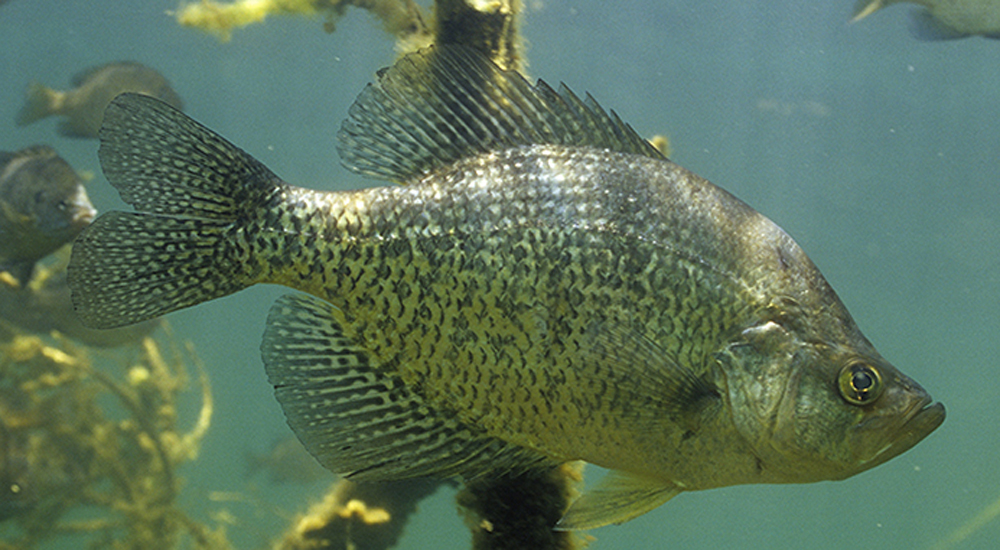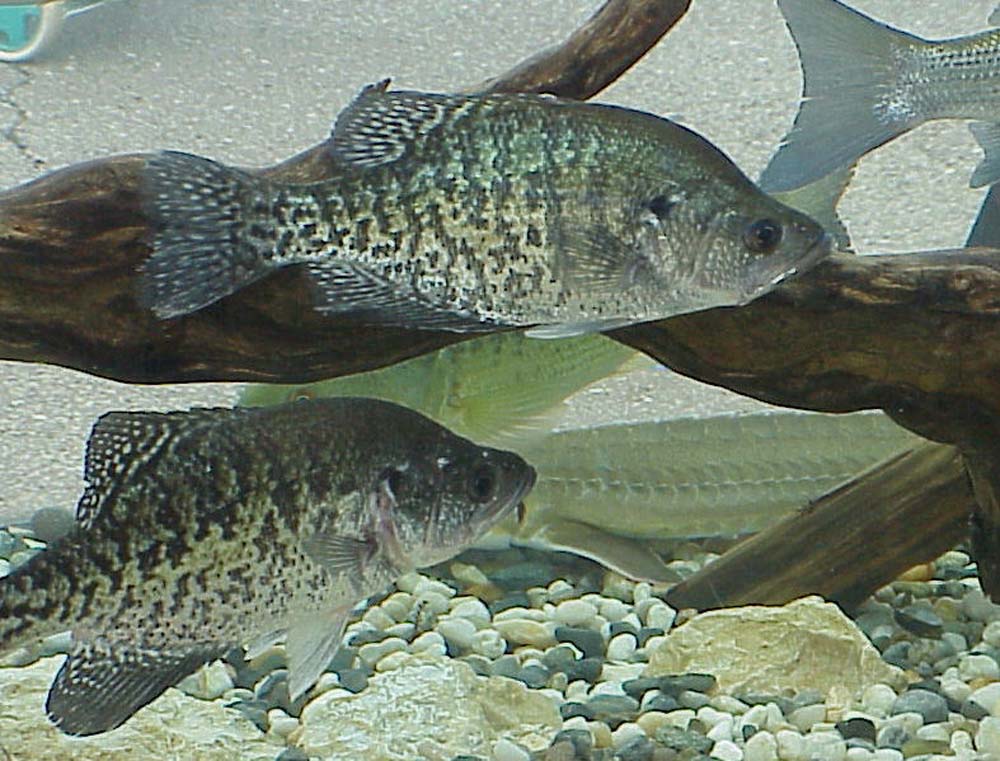
Black crappie (Pomoxis nigromaculatus) Illinois Department of Natural Resources. Photo Engbretson Underwater Photography
Making crappie a target when it’s too warm for trout
By Skip Clement
Much of this year’s mid to late summer trout fly fishing conversation is rightly getting focused on warnings—these warnings are direr than last year. Again, like last year’s heat dome effect, our best trout water states are losing significant stocks due to deforestation from fires, low water, extraordinary drought conditions, and high temperatures. Some western states report water at plus 80º – unliveable for native cutthroats and their derivatives, trouts and several generations of browns.
It fought to the death of itself
In some states or regions, the aforementioned adverse conditions do not yet exist. Still, decent catch and release practices remain responsible for protecting resources in unseasonably warm summer months. For example, catching and releasing a 10-pound brown fought for 28 minutes on a 2-weight is not worth releasing – it will die from exhaustion just as a 5-pound bonefish would in its own flats environment when played to death with too light a weight fly rod in hotter season waters.
Show me the crappies
My friend and consummate professor, writer, contributor, and author of over 20 books, Steve Hudson. Steve is a master fly angler and loves catching the sunfishes on light fly rods. His only fly for years has been one he developed called a Brim Buster. Steve says that summer is still an excellent crappie time, and research and reality support his claim.
Another friend and consummate angler, Mike Growchowski, has been a consistent provider of succulent white meat carved from the carcasses of his crappie outings. A few days ago, a recently obtained one-pound wrapper of crappie meat awaited my batching up some hush puppies, grits, and coleslaw made by fellow angler and fishing partner, Angie Roth.

My attempt at Steve’s Brim Buster – it is a one-off and attracts bream and crappie to snook and reds in the salt. It has a Woolly Bugger great uncle. Steve fishes his Brim Buster exclusively and prefers white. I keep a supply in various colors and combos, as well as, hook sizes. Like Russell Blessings’ Wooly Bugger, Hudson’s Brim Buster scores well on away games.

My oft times sidekick, Mike Growchowski, is shown here with his unexpected hookup last November in Georgia’s Lake Allatoona. “I was sure I’d caught a hybrid striper – it tugged like one, but when it came into view of about 8-feet, I couldn’t believe what I saw, black crappie that turned out to be just shy of the state record. The crappie was 2lbs, 15oz. I caught it on a small jigging rod with 1/8oz Bobby Garland – threadfin [shad].”
I’m trying to convince Angie that crappie is a worthy alternative to her trout persuasion, and not give up fly fishing in the heat of summer
Note: Winter or colder weather crappie meat tastes better than warmer weather caught crappie. Both, however, are delicious. Warm weather meat just add a little seasoning. Winter cook and eat.
Crappies, bluegills, sunfish, panfishes et al. – some facts:
Crappies, like all fish – bluegills, sunfish, panfishes et al., are completely governed by water temperature. It triggers their seasonal movements. Recognizing this relationship between temperature and location are the way one catches these papermouths or one who just fishes.
By March, most Southern crappie waters have warmed into the 50ºs. When the water temperature is 50º to 56º degrees, most crappies will be found staging on flats ranging from 6- to 15-feet deep.
“Whenever anglers start catching fish shallow they often think the fish must be spawning. Actually they’re in the pre-spawn feeding frenzy. During this time anglers should look for flats. Structure is not as important as forage.
— Kentucky Department of Fish and Wildlife Resources biologist Paul Rister
“This understanding has been accepted by most wildlife biologist with strong crappie populations as far away as the southern Canada. Further, Rister says, crappies begin spawning when the water hits 57º degrees. At Kentucky Lake, the origin of Rister’s a study, spawning fish can be found in any shallow-water habitat ranging from 18-inches to 3-feet deep-deeper in clearer Southern reservoirs. Southern crappie alers [?] should target four specific cover types:
- buttonball bush
- water willow
- willow trees
- cypress trees
Other Factors
- During the low-light periods, such as dawn or dusk, crappies will vacate their aquatic shelters to feed
- Some will feed along shallow banks, usually by chasing small baitfish
- Crappies will suspend near brush along secondary channels
- Crappies gravitate to the creeks that once fed the main river
- Black crappies remain in shallow water long after the spawn, while white crappies spawned and quickly migrated offshore
- To explore bank cover fish vertically
- In more open water, try to locate crappies that are near submerged cover

Some alternative crappie flies with creds. Image YouTube screenshot – Arkansas Fishing Adventures, Sep 27, 2019.
Summertime Myths:
— Kentucky Department of Fish and Wildlife Resources biologist Paul Rister
Most anglers believe that after crappies spawn they move back out to the river channels where they suspend and become extremely difficult to catch. But the Kentucky Lake telemetry study suggests that’s not the case.
In 2003 the study focused on Blood Creek, the largest secondary channel on the Kentucky portion of Kentucky Lake. The study was inspired by several complaints filtering in from crappie anglers in the area. Catches were down, yet the state maintained that Kentucky Lake harbored its largest populations of crappies ever. So what was happening?
What biologists found through trap-net studies was that black crappies, which prior to 1997 made up only 18 percent of the catch, were by 2003 significantly outnumbering the whites. Since 1997, black crappies made up 72 percent of the trap net catch, but anglers caught no more than they ever did. While the crappie population was increasing overall-mostly due to an explosion of black crappies-anglers were not cashing in.
The study proved that black crappies remained shallow long after the spawn, while white crappies spawned and quickly migrated offshore. Rister notes many of the black crappies were still shallow in early July, even though the water temperature was 80º degrees.

White Crappies – Wikipedia.
Black crappy will overtake the white crappie population
Rister speculates that crappie anglers were vacating shallow water to chase white crappies, as they always had. In recent years the diminishing white crappie population became harder to find, however, and consequently were more difficult to catch. Fishing shallow for black crappies, even in June and July, could solve the problem of diminished harvests for crappie fishermen at Kentucky Lake, and wherever else the species is dominant or thriving.
“If our transmitters had lasted a month or two longer we would have probably seen the blacks move out to the flats in five to six feet of water and pretty much stay there,” says Rister.
The biologist also notes that brush is important because the summertime blacks are habitat-oriented, especially in shallow water. In the fall, black crappies can still be found fairly shallow. While the Kentucky Department of Fish and Wildlife Resources hasn’t conducted any autumn telemetry studies, researchers have set out nets during that period for population surveys. Most of the nets are set in 5-to 15-feet of water during October. Rister says the number of black crappies caught in these nets indicates that they are still using shallow water.






